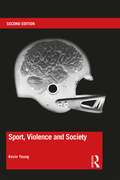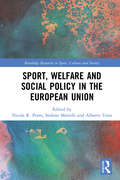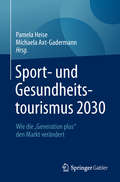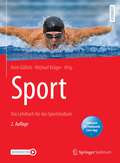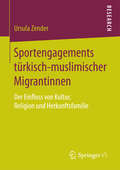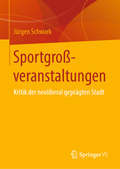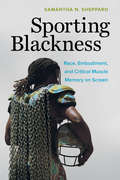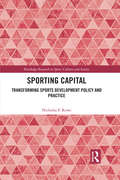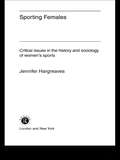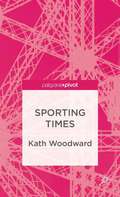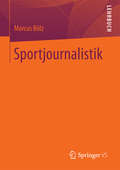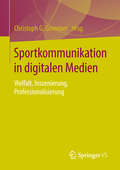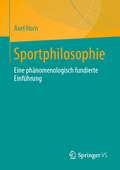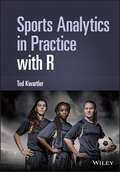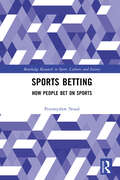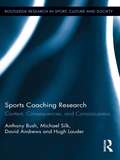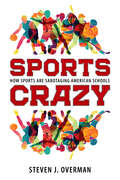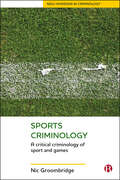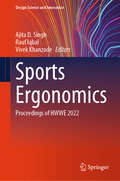- Table View
- List View
Sport, Theory and Social Problems: A Critical Introduction
by Eric Anderson Adam WhiteIn a revised, updated, and considerably expanded new edition of Sport, Theory and Social Problems, authors Eric Anderson and Adam White examine how the structure and culture of sport promotes inequality, injury, and complicity to authority at the non-elite levels of play in Anglo-American countries. By introducing students to a research-led perspective on sport, it highlights the operation of power, patriarchy, and pain that a hyper-competitive sporting culture promotes. Each chapter includes at least one key social theory, which is made accessible and pragmatic. The theory is then infused throughout the chapter to help the student engage with a deeper understanding of sport. In addition to examining how sport generates otherness, distracts children from education, and teaches the acceptance of emotional and physical violence, this new edition also examines how organized, competitive sport divides us by race, denies children the right to their own governance, and promotes brain trauma and chronic traumatic encephalopathy in those who are too young to consent to play contact sports. Sport, Theory and Social Problems: A Critical Introduction is an essential textbook for any sport studies degree with a focus on the sociology of sport, sport and social theory, children’s health and wellbeing, or sport and gender studies.
Sport, Violence and Society: Second edition
by Kevin YoungIn this fully updated and revised new edition of his landmark study of violence in and around contemporary sport, Kevin Young offers a comprehensive sociological analysis of an issue of central importance within sport studies. The book explores organised and spontaneous violence, both on the field and off, and calls for a much broader definition of ‘sports-related violence’, to include issues as diverse as criminal behaviour by players, abuse within sport and exploitative labour practices. Offering a sophisticated theoretical framework for understanding violence in a sporting context and including new case studies and updated empirical data – from professional soccer in Europe to ice hockey in North America – the book establishes a benchmark for the study of violence within sport and wider society. Through close examination of often contradictory trends, from anti-violence initiatives in professional sports leagues to the role of the media in encouraging hyper-aggression, the book throws new light on our understanding of the socially-embedded character of sport and its fundamental ties to history, culture, politics, social class, gender and the law. This new edition also recognises burgeoning new literatures, such as research examining concussion and the link between sport and mental illness and includes student-friendly pedagogical aids, such as critical thinking questions at the end of each chapter. Sport, Violence and Society is a vital read for anyone studying or working in the areas of the Sociology of Sport, Sport Psychology, Ethics and Philosophy of Sport, Sport and Politics, Sports History, and Sport and the Media.
Sport, Welfare and Social Policy in the European Union (Routledge Research in Sport, Culture and Society)
by Alberto Testa Stefano Martelli Nicola R. PorroSport is often seen as an indicator of the civic maturity of a community, an aspect of the rights of citizens to health, education and social integration. This book examines the relationships between participation in sport and physical activity, and welfare policies across Europe. It argues that the success of campaigns for the promotion of sport depend on the existence of dedicated welfare policies promoted by the European states and explores variations in cultural models and structures of governance across Europe. Addressing the function of supranational institutions such as the EU as well as voluntary networks, the book illuminates key issues in European societies such as migration, financial austerity and Brexit as they relate to sport policy. This is important reading for scholars and students in the fields of European sport and physical activity, sociology, political science and organisational analysis, as well as operators and managers of the sport systems involved in advanced training programmes.
Sport- und Gesundheitstourismus 2030: Wie die „Generation plus“ den Markt verändert
by Pamela Heise Michaela Axt-GadermannDieses Fachbuch fokussiert auf das sport- und gesundheitstouristische Nachfrageverhalten der "Generation plus". Einer Konsumentengruppe in ihrer zweiten Lebenshälfte, die mit einer großen Neugier in Bezug auf sich selbst und die Welt und einem Plus an Interessen, Anspruch und Kaufkraft ausgestattet ist. Durch die sich wandelnden soziodemographischen, ökonomischen und klimatischen Rahmenbedingungen ergeben sich auch im Bereich der Freizeit- und Tourismusbranche signifikante Änderungen zu den bisherigen Nachfrage- und Angebotsstrukturen. Destinationen, die sich bereits jetzt mit der wachsenden Zahl reifer Touristen beschäftigen, stellen ihre Weichen in Richtung Zukunft.Das Buch greift vor dem Hintergrund des demographischen Wandels aktuelle touristische Entwicklungen und zukünftige Herausforderungen auf, denen sich Destinationen und Anbieter im Sinne der Wettbewerbsfähigkeit stellen müssen. Das Buch richtet sich durch die Symbiose aus Theorie und Praxis im Sinne eines Handlungsleitfadens u.a. an Entscheider und Produktentwickler im touristischen Destinations- und Eventkontext, an Lehrende und Studierende sowie an alle, die eine anregende Lektüre suchen.
Sport: A Biological, Philosophical, and Cultural Perspective
by Jay SchulkinSports are as varied as the people who play them. We run, jump, and swim. We kick, hit, and shoot balls. We ride sleds in the snow and surf in the sea. From the Olympians of ancient Greece to today's professional athletes, from adult pickup soccer games to children's gymnastics classes, people at all levels of ability at all times and in all places have engaged in sport. What drives this phenomenon?In Sport, the neuroscientist Jay Schulkin argues that biology and culture do more than coexist when we play sports—they blend together seamlessly, propelling each other toward greater physical and intellectual achievement. To support this claim, Schulkin discusses history, literature, and art—and engages philosophical inquiry and recent behavioral research. He connects sport's basic neural requirements, including spatial and temporal awareness, inference, memory, agency, direction, competitive spirit, and endurance, to the demands of other human activities. He affirms sport's natural role as a creative evolutionary catalyst, turning the external play of sports inward and bringing insight to the diversion that defines our species. Sport, we learn, is a fundamental part of human life.
Sport: Das Lehrbuch für das Sportstudium
by Martin LayDie vollständig überarbeite Neuauflage des Lehrbuchklassikers knüpft an das bewährte Konzept der Erstauflage an und umfasst alle wesentlichen Themenfelder und Inhaltsbereiche für ein erfolgreiches Sportstudium. Abseits einer grundlegenden Aktualisierung zeichnet sich die Folgeauflage insbesondere durch eine Vielzahl an digitalen Zusatzmaterialien aus. Für Studierende wird somit eine innovative Möglichkeit zur multimedialen Wissensvermittlung geschaffen, die weit über das geschriebene Buch hinausgeht. In diesem Lehrbuch erfahren Sie die aktuellen Erkenntnisse zu den vielfältigen Facetten des modernen Sports: Vom Schulsport über den Freizeit-, Breiten-, Fitness- und Gesundheitssport bis hin zum Wettkampf- und Spitzensport. Renommierte Expertinnen und Experten der Trainingswissenschaft, Medizin, Sozialwissenschaften und Pädagogik erklären die aktuelle Theorie und Praxis des Sports speziell für Ihr Sportstudium.Herausragende Merkmale sind:Verständliche Erklärungen von Fachkräften mit ausgiebiger PraxiserfahrungHervorhebung des Wichtigsten in prägnanten MerksätzenZahlreiche praktische Beispiele, Verbindung von Theorie und PraxisAnschauliche Darstellung mit ca. 400 farbigen Bildern und GrafikenUmfangreiches Glossar zum Nachschlagen von DefinitionenDigitale Übungsfragen zur Lernkontrolle und PrüfungsvorbereitungAbrufbare Videos für eine multimediale WissensvermittlungDas Lehrbuch Sport konzentriert sich auf die Inhalte der Bachelorstudiengänge mit Sportbezug. Nahezu alle Module des Bachelorstudiums finden sich in den Kapiteln wieder. Zusätzlich bietet es zentrale Grundlagen für die verschiedenen Sport-Masterstudiengänge, Fort- und Weiterbildungen von Sportlehrkräften und Sportfachpersonal in den vielfältigen Berufsfeldern sowie für den Leistungskurs Sport.
Sportengagements türkisch-muslimischer Migrantinnen
by Ursula ZenderUrsula Zender untersucht, weshalb türkisch-muslimische Migrantinnen im organisierten Sport in Deutschland so stark unterrepräsentiert sind. Sie geht der Frage nach, welche Faktoren den Zugang zum Sport im Allgemeinen und zum Sportverein im Besonderen bestimmen und fokussiert dabei Kultur, Religion, traditionelle Geschlechterrollen, die Herkunftsfamilie und die Offenheit der Sportvereine. Ihre Arbeit ist sozialisationstheoretisch ausgerichtet und beleuchtet mithilfe der Dokumentarischen Methode die Bedeutung von Sportengagements im Lebenslauf türkisch-muslimischer Migrantinnen.
Sportgroßveranstaltungen: Kritik der neoliberal geprägten Stadt
by Jürgen SchwarkInsofern sich Städte als „Unternehmen“ begreifen (sollen), werden Sportgroßveranstaltungen als „Standortfaktor“ benutzt, so dass die Förderung des Sports und seiner kulturellen Potentiale in den Hintergrund gedrängt werden. Dadurch ist aber die Zustimmung zu den großen Veranstaltungen des Sports nicht mehr ungeteilt. Zusätzlich besteht die Problematik, wie viel sich Städte die von ihnen (mit)ausgerichteten Sportgroßveranstaltungen etwas kosten lassen wollen, bzw. überhaupt noch können. Mit einer interdisziplinären und kritischen Herangehensweise richtet der Band seinen Blick auf die Felder der Verwaltung, der Ökonomie und Politik sowie auf den Sport als kulturelle Praxis. Aus dieser Perspektive zeigt das Buch sport- und wirtschaftspolitische Orientierungen für einen angemessenen und konzeptionellen Umgang mit Sportgroßveranstaltungen auf.Der AutorJürgen Schwark, Prof. Dr. phil. habil. Dipl. Soz.Wiss., lehrt hauptberuflich BWL/Tourismus an der Westfälischen Hochschule, Campus Bocholt und ist Dozent am Institut für Europäische Sportentwicklung und Freizeitforschung der Deutschen Sporthochschule Köln.
Sporting Blackness: Race, Embodiment, and Critical Muscle Memory on Screen
by Samantha N. SheppardSporting Blackness examines issues of race and representation in sports films, exploring what it means to embody, perform, play out, and contest blackness by representations of Black athletes on screen. By presenting new critical terms, Sheppard analyzes not only "skin in the game," or how racial representation shapes the genre’s imagery, but also "skin in the genre," or the formal consequences of blackness on the sport film genre’s modes, codes, and conventions. Through a rich interdisciplinary approach, Sheppard argues that representations of Black sporting bodies contain "critical muscle memories": embodied, kinesthetic, and cinematic histories that go beyond a film’s plot to index, circulate, and reproduce broader narratives about Black sporting and non-sporting experiences in American society.
Sporting Capital: Transforming Sports Development Policy and Practice (Routledge Research in Sport, Culture and Society)
by Nicholas F. RoweIn a world of competing public policy priorities, economic challenges and political uncertainty, sports development organisations and initiatives need to adapt to survive. This book makes the case for 'Sporting Capital' as a new conceptual model of sports participation with the potential to transform public policy and practice in sports development. The central argument presented is that a model of Sporting Capital - with its three domains of physiological, social and psychological attributes - provides a missing framework, creating a new impetus for sustained growth in community sport by joining up the levels at which sports development is planned and implemented. Touching on important issues such as youth sport, public health, volunteering, disability, ethnicity and social inequality, it examines patterns of sports participation in relation to age, gender and social class and offers recommendations for strategic policy improvements that can be implemented by practitioners working on the frontline of community sport. Sporting Capital: Transforming Sports Development Policy and Practice provides valuable insights for all those interested in sports development, youth sport, community sport, or sport and social policy.
Sporting Cultures: Hispanic Perspectives on Sport, Text and the Body (Sport in the Global Society)
by Boria Majumdar J. A. Mangan Mark DyersonThe essays that comprise this book mark new territory in the study of sport in the Hispanic world, a key site of cultural experience for the populations of Latin America, the United States and the Iberian Peninsula. The scope of the volume is the exploration of the representation and interaction of sport / text / body in a variety of cultural forms in Latin America, Spain and the chicano population of the USA. As such, it opens a path for further study of an area that is experiencing significant growth in the international academic community. The book consists of 11 chapters by different authors, and an introduction, totalling c.85,000 words. The essays deal with the key sporting practices of the Hispanic world, including boxing, baseball, athletics, Olympic movements and football, approaching them as physical manifestations in their own right and as cultural representations (via media images, poetry, narrative fiction, murals) through the research methodologies of the humanities and social sciences. This book was previously published as a special issue of the International Journal of the History of Sport
Sporting Equality: Title IX Thirty Years Later
by Rita J. SimonAs part of its Education Amendments, the United States Congress passed Title IX in 1972 to ensure that no person should be discriminated against in any education program or activity receiving federal financial assistance. In the decades since, Title IX has had, among other effects, a marked increase on school athletic programs for women and girls at both the high school and college level. Despite this, a range of questions have been raised about the effectiveness of the federal government's enforcement, and also the impact on male athletics. The government can enact legislation, but how it works remains the domain of administrators at one end and thousands of athletes at the other. Sporting Equality reviews the impact of Title IX thirty years after its passage, and suggests future areas of contention.This new title includes the major findings and recommendations of the Secretary of Education's Commission on Opportunities in Athletics established in 2002, as well as the commission's minority report. These contributions are followed by seven chapters that analyze and assess the strength and weakness of Title IX and offer recommendations for strengthening or changing its goals and objectives. These include: Kimberly A. Yuracko, ""Title IX and the Problem of Gender Equality in Athletics""; Eric C. Dudley, Jr. and George Rutherglen, ""A Comment on the Report of the Commission to Review Title IX""; Barbara Murray, ""How to Evaluate the Implementation of Title IX at Colleges and Universities and Attitudes and Interest of Students Regarding Athletics""; John J. Cheslock and Deborah Anderson, ""Lessons From Research on Title IX and Intercollegiate Athletics""; Valerie M. Bonnette, ""The Little Fusses Over Title IX.""The book concludes with two controversial chapters. The first, by Leo Kocher, argues that Title IX has been detrimental to male athletics, especially gymnastics, swimming, wrestling, and track, while the second by Ellen J. Staurowsky claims that T
Sporting Females: Critical Issues in the History and Sociology of Women's Sport
by Jennifer Hargreaves1994 North American Society for the Sociology of Sport Annual Book AwardAn outstanding contribution to feminist analysis of sport from the nineteenth century to the present day. Jennifer Hargreaves views sport as a battle for control of the physical body and an important area for feminist intervention. Placing women at the centre of discussion, no other book is as comprehensive.
Sporting Gentlemen: Men's Tennis from the Age of Honor to the Cult of the Superstar
by E. Digby BaltzellTennis is a high-stakes game, played by prodigies identified early and coached by professionals in hopes of high rankings and endorsements. This commercial world is far removed from the origins of the sport. Before 1968—when Wimbledon invited professional players to compete for the first time—tennis was part of a sportsmanship tradition that emphasized character over money. It produced well-rounded gentlemen who expressed a code of honor, not commerce.In this authoritative and affectionate history of men's tennis, distinguished sociologist E. Digby Baltzell recovers the glory of the age. From its aristocratic origins in the late ninteenth century, to the Tilden years, and through a succession of newcomers, the amateur era and its virtues survived a century of democratization and conflict. Sporting Gentlemen examines the greatest players and matches in the history of tennis. Baltzell explores the tennis code of honor and its roots in the cricket code of the late-nineteenth-century Anglo-American upper class.This code of honor remained in spite of the later democratization of tennis. Thus, the court manners of the Renshaw twins and Doherty brothers at the Old Wimbledon were upheld to the letter by Don Budge and Jack Kramer as well as Rod Laver, John Newcombe, and Arthur Ashe. Baltzell's final chapter on the Open Era is a blistering attack on the decline of honor and the obliteration of class distinctions, leaving only those based on money. For all who love the game of tennis, Sporting Gentlemen is both fascinating history and a badly needed analysis of what has made the sport great.
Sporting Times
by Kath WoodwardWritten against the backdrop of the 2012 London Olympics, this book examines the idea of 'time' in sport, using time as a conceptual lens to explore movement, bodies, sports reporting, memory, disability, technology and the role of the past and the future in sport.
Sportjournalistik
by Marcus BölzDer Band bereitet die systematisch und empirisch fundierten Ergebnisse der Sportjournalistik didaktisch auf: Wie die Arbeit der Sportjournalisten konkret aussieht, welche Rahmenbedingungen diese Arbeit prägen und wie Akteure und Rezipienten sportjournalistische Medientexte herstellen, distribuieren und rezipieren. In dem Buch werden dazu die wichtigsten Modelle, Theorien und wissenschaftlichen Befunde dargelegt, anhand von Beispielen der Transfer der Inhalte vom Theoretischen zum Anschaulich-Praktischen vollzogen und die Inhalte und Positionen kritisch reflektiert.
Sportkommunikation in digitalen Medien: Vielfalt, Inszenierung, Professionalisierung
by Christoph G. GrimmerUnter den Perspektiven Vielfalt, Inszenierung und Professionalisierung analysieren Wissenschaftler und Praxisexperten aktuelle Potentiale und Herausforderungen im Bereich digitaler Sportkommunikation. Die Autorinnen und Autoren werfen einen Blick auf verschiedene Sportarten, Nutzergruppen bzw. Kontexte. Nach einer Einführung zur Rolle Sozialer Medien im Sport widmen sich weitere Beiträge der Vielfalt des PR-Einsatzes im Basketball und österreichischen Profifußball. Der Schwerpunkt des Buches liegt auf der Perspektive Inszenierung und fokussiert die darstellerischen Möglichkeiten für u.a. Prominente, Olympioniken und Journalisten. Mit 360 Grad-Videos wird eine bislang in der Wissenschaft weitgehend ausgeblendete Innovation der Social Media-Kommunikation aufgegriffen. Im dritten Teil erhält der Leser vertiefende Einblicke in die durch Soziale Medien beeinflusste Öffentlichkeitsarbeit von Pressesprechern und Kommunikationsagenturen.
Sportphilosophie: Eine phänomenologisch fundierte Einführung
by Axel HornDie Einführung gibt einen Überblick über Inhalte und Methoden, holt den Leser mit seinen Vorverständnissen über Philosophie und Sport ab und eröffnet den Horizont für Themen, Fragen, Problemstellungen und Lösungsansätze einer Sportphilosophie.Der zweite Teil des Buches beschäftigt sich mit der Phänomenologie als einer der grundlegenden Strömungen der Philosophie des 20. Jahrhunderts. Er zeichnet Anliegen und Entwicklung der Phänomenologie anhand einiger ihrer Hauptvertreter nach und arbeitet mit „Phänomenologien der Leiblichkeit“ ein zeitgemäßes Verständnis von Körper respektive Leib heraus.Im dritten Teil geht es um eine „Phänomenologie des heutigen Sports“. Sport ist längst eine feste gesellschaftliche Größe und ein florierender wirtschaftlicher Bereich geworden. Das Buch analysiert die Verbindung des Sports zu Geld, Macht, Politik, Medien, Doping und die Rolle, die er hinsichtlich Körperkult, Spiel, Gesundheit, Bildung usw. spielt. Der Autor geht den Fragen nach, wie sich die Phänomene genauer darstellen, was sie „eigentlich“ zum Vorschein bringen, und ob der Sport tatsächlich einem Umgang mit dem Körper respektive dem Leib entspricht, wie er im philosophischen Verständnis der Leiblichkeit dargelegt wurde.
Sportpsychologie: Grundlagen und Anwendung
by Henning Plessner Julia Schüler Mirko WegnerDieses Lehrbuch richtet sich an Studierende der Psychologie und Sportwissenschaft sowie an Personen, die in der Sportpraxis tätig sind und Themen der Sportpsychologie genauer und tiefgehender verstehen möchten. Zahlreiche auflockernde didaktische Elemente ermöglichen Ihnen das leichtgängige und freudvolle Lernen komplexer Sachverhalte. Im ersten Teil lernen Sie den Facettenreichtum der Sportpsychologie sowie die Untrennbarkeit von Theorie und Sportpraxis kennen. Theoretische Grundlagen sind nach den Subdisziplinen der Psychologie (Kognition, Motivation, Emotion, Persönlichkeit und soziale Prozesse) untergliedert und verständlich sowie praxisnah erläutert. Dabei werden Fragen beantwortet wie: Welche kognitiven Prozesse führen zu guten Entscheidungen in kritischen Sportspielsituationen? Wie entsteht intrinsische Motivation zum Sporttreiben? Welche Folgen hat Wettkampfangst? Trägt Sport zur Persönlichkeitsentwicklung bei? Wie hängen Teamklima und sportliche Leistung zusammen? Im zweiten Teil erfahren Sie alles Wichtige über die Anwendung der Sportpsychologie in den Kontexten Leistung und Gesundheit. Wie sehen beispielsweise theoriebasierte psychologische Trainings zur Leistungssteigerung im Spitzensport aus und wie effektiv sind diese? Besteht ein Zusammenhang zwischen Sport und Gesundheit? Die von den jeweiligen Fachexperten und -expertinnen verfassten Kapitel stellen eine umfassende und optimale Prüfungsvorbereitung dar. Zudem unterstützen die klare Struktur und Didaktik sowie die in sich abgeschlossenen Kapitel dabei, sich beim Vertiefen oder Nachlesen auf einzelne Inhaltsbereiche zu fokussieren. Das Werk ist prüfungsrelevant und regt zugleich mit wertvollen Impulsen zum Mit- und Weiterdenken an.
Sports Analytics in Practice with R
by Ted KwartlerSports Analytics in Practice with R A practical guide for those looking to employ the latest and leading analytical software in sport In the last twenty years, sports organizations have become a data-driven business. Before this, most decisions in sports were qualitatively driven by subject-matter experts. In the years since numerous teams found success with “Money Ball” analytical perspectives, the industry has sought to advance its analytical acumen to improve on- and off-field outcomes. The increasing demand for data to inform decisions for coaches, scouts, and players before and during sporting events has led to intriguing efforts to build upon this quantitative approach. As this methodology for assessing performance has matured and grown in importance, so too has the open-source R software emerged as one of the leading analytical software packages. In fact, R is a top 10 programming language that is useful in academia and industry for statistics, machine learning, and rapid prototyping. Sports Analytics in Practice with R neatly marries these two advances to teach basic analytics for sports-related use—from cricket to baseball, from basketball to tennis, from soccer to sports gambling, and more. Sports Analytics in Practice with R readers will also find: A broad perspective of sports, focusing on a wide range of sports rather than just one The first book of its kind that features coding examples Case study approach throughout the book Companion website including data sets to work through alongside the explanations Sports Analytics in Practice with R is a helpful tool for students and professionals in the sports management field, but also for sports enthusiasts who have a coding background.
Sports Betting: How People Bet on Sports (Routledge Research in Sport, Culture and Society)
by Przemysław NosalThis is the first book to focus on sports betting from a sociological perspective. Drawing on multi-stage sociological research, it deepens our understanding of an increasingly significant aspect of the contemporary sport industry.The book examines how bettors engage in sports betting – why they perceive it to be attractive, what betting represents to them and how they know how to bet or how they do so – describing the social phenomenon of betting and placing it within a broader cultural context. Drawing on original empirical research, it uses a practice theory that makes it possible to see in the actions of individuals both the influence of and the impact they have on culture, lifestyle and technology. With sports betting an increasingly controversial subject in wider society, this analysis helps us to understand betting as a complex phenomenon with connections to other areas of social life and how to better understand its impacts and how to mitigate its potential social harms.This is a fascinating read for anyone with an interest in the sociology of sport, sport business, economy, psychology, gambling, sociology, cultural studies, social anthropology or social policy.
Sports Coaching Research: Context, Consequences, and Consciousness (Routledge Research in Sport, Culture and Society #20)
by David Andrews Michael Silk Hugh Lauder Anthony BushThis book raises critical questions about the explanatory framework guiding sports coaching research and presents a new conceptualization for research in the field. Through mapping and contextualizing sports coaching research within a corporatized higher education, the dominant or legitimate forms of sports coaching knowledge are problematized and a new vision of the field, which is socially and culturally responsive, communitarian and justice-oriented emerges.
Sports Crazy: How Sports Are Sabotaging American Schools
by Steven J. OvermanSports Crazy: How Sports Are Sabotaging American Schools exposes the excesses of middle and high school sports and the detrimental effects our sports obsession has on American education. Institutions are increasingly emulating college and professional sports models and losing sight of a host of educational and health goals.Steven J. Overman describes how this agenda is driven largely by partisan fans and parents of athletes who exert an inordinate influence on school priorities, and he explains how and why school administrators shockingly and consistently capitulate to these demands. The author underscores the incongruity of public schools involved in an entertainment business and the effects this diversion has on academic integrity, learning, life experience, and overall educational outcomes.Overman examines out-of-control school sports within the context of a school’s educational mission and curriculum, with telling reference to impacts on physical education. He explores as well the outsized place of interscholastic sports beyond the classroom and scrutinizes the distorted relationship between intramural or recreational sports and elitist, varsity athletics. Overman’s chapter on tackle football explains many reasons why this sport should be eliminated from the school extracurriculum and replaced by flag or touch football.Overman presents a brief history of interscholastic sports, and he compares and contrasts the American experience of school-sponsored sport to the European model of community-based clubs. Which approach better serves students? Overman recommends reforms in the context of a radical proposal to phase out interscholastic sports in favor of an intramural or club model. This approach would alleviate such problems as elitism and gender bias and reign in hypercompetitiveness while freeing schools to educate students rather than provide public entertainment.
Sports Criminology: A Critical Criminology of Sport and Games (New Horizons in Criminology)
by Nic GroombridgeThis is the first book to provide a critical criminological perspective on sport and the connections between sport and crime. It draws on the inter-disciplinary nature of criminology and incorporates emerging perspectives like social harm, gender and sexuality, and green criminology. Written from an international perspective, it covers topics including sports scandals and the possibility of crime prevention through sport. American football, boxing, soccer and sumo are all examined. The book considers both sports law and the sociology of sport and will be essential reading for students and academics in these fields.
Sports Ergonomics: Proceedings of HWWE 2022 (Design Science and Innovation)
by Rauf Iqbal Vivek Khanzode Ajita D. SinghThis book presents select proceedings of the International Conference on Humanizing Work and Work Environment (HWWE-2022) conducted at Punjabi University, Patiala. The conference proceedings examine a range of issues confronted by researchers and practitioners in the field of ergonomics and human factors engineering today. The book showcases latest research on physical ergonomics, workplace design, product design for usability, user interface and experience design, and assessment of cognitive workload, among other topics. The book also discusses various methodological approaches used by researchers and scientists in the field of ergonomics, such as participatory ergonomics, survey research, experimental design, data driven modeling and other recent approaches. This book will be a useful reference for researchers, practitioners, professionals, and consultants in the field of ergonomics, human factors engineering, and worksystem design.

